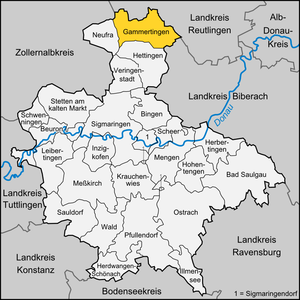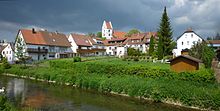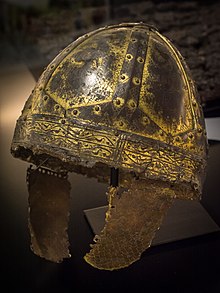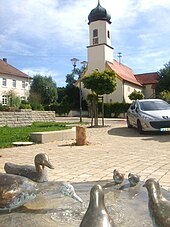Gammertingen
| coat of arms | Germany map | |
|---|---|---|
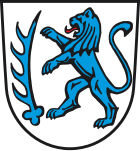
|
Coordinates: 48 ° 15 ' N , 9 ° 13' E |
|
| Basic data | ||
| State : | Baden-Württemberg | |
| Administrative region : | Tübingen | |
| County : | Sigmaringen | |
| Height : | 662 m above sea level NHN | |
| Area : | 52.97 km 2 | |
| Residents: | 6320 (December 31, 2018) | |
| Population density : | 119 inhabitants per km 2 | |
| Postal code : | 72501 | |
| Primaries : | 07574 07124 (OT Mariaberg ) |
|
| License plate : | SIG | |
| Community key : | 08 4 37 031 | |
| City structure: | 6 districts | |
City administration address : |
Hohenzollernstrasse 5 72501 Gammertingen |
|
| Website : | ||
| Mayor : | Holger Jerg | |
| Location of the city of Gammertingen in the district of Sigmaringen | ||
Gammertingen is a small town in the Sigmaringen district in Baden-Württemberg .
geography
Geographical location
Gammertingen is located on the Swabian Alb in the Lauchert valley , a tributary of the Danube .
Neighboring communities
The following cities and communities border the city of Gammertingen. They are called clockwise , starting in the northeast:
Pfronstetten ( Reutlingen district ), Langenenslingen ( Biberach district ), Hettingen , Neufra , Burladingen ( Zollernalb district ), Trochtelfingen (Reutlingen district).
City structure
In addition to the core city of Gammertingen with around 5000 inhabitants, the city as a whole also includes five districts, including the three sub-communities Feldhausen , Harthausen and Kettenacker together with the princely Hohenzollern domain Lusthof on the plateau of the Swabian Alb, as well as Bronnen and Mariaberg .
| coat of arms | District | Residents | surface |
|---|---|---|---|
| Gammertingen (core city) | 5,000 | 1,769 ha | |
| Well | > 500 | ? | |
| Feldhausen | about 400 | 991 ha | |
| Harthausen | about 250 | 671 ha | |
| Chain field | about 300 | 1,084 ha | |
| Mariaberg | > 500 | ? |
history
prehistory
The historical roots of Gammertingen go back to the Bronze Age . A Roman coin found dates back to a time between 341 and 354 AD, when the Roman Limes had become meaningless in the region. The well-known Spangenhelm von Gammertingen and other rich grave goods from a row grave field provide information about an early settlement in the Merovingian period . The bronze-gilded Spangenhelm from the late 6th century from an Alemannic princely grave near Gammertingen is in the Princely Hohenzollern Collections in Sigmaringen.
Middle Ages and early modern times
Gammertingen was first mentioned in 1101 on a document from the Allerheiligen monastery in Schaffhausen . At that time the place belonged to the Counts of Gammertingen , who also had possessions in the Upper Engadin . Later the property went to the Counts of Veringen . Gammertingen was first mentioned as a town in 1311. From 1524 the barons of Speth zu Zwiefalten were the owners. This lasted until 1806, when the Principality of Hohenzollern-Sigmaringen gained sovereignty and Gammertingen became a Prussian-Hohenzollern high-ranking town . In the Hohenzollern and later Prussian times, Gammertingen was the seat of the Oberamt, District Court, Forestry Office and land registry office.
20th century
In the time of National Socialism , Gammertingen was one of five camps of the female Reich Labor Service (RAD) in what was then the Prussian-Hohenzollern district of Sigmaringen. In 1940, as part of the “ euthanasia ” campaign T4, the Nazi rulers relocated 61 disabled people from the Mariaberg home to Grafeneck and murdered them there. Since 1990 a memorial has been commemorating these crimes with a stele by the sculptor Harald Walter with accompanying text panels. A permanent exhibition in the Benedictine monastery also provides information about this.
During the Cold War , NATO planned the so-called Gammertingen / Birkhof Air Base to station a fighter-bomber squadron with two F-104G squadrons . This should arise four kilometers southwest of Gammertingen. The planning lasted from 1958 to 1963 and was then abandoned after the project had turned out to be too complex. In addition to the problems with the source catchment for the Gammerting drinking water supply and the not inconsiderable earthworks, there was stubborn resistance from the owner of the Birkhof domain.
Incorporations
The formerly independent community of Harthausen bei Feldhausen was voluntarily incorporated into the city of Gammertingen on January 1, 1971 under Leo Leipert († 2009), Mayor of Harthausen from 1967 until it was incorporated. On January 1, 1975, the previously independent communities of Bronnen, Feldhausen and Kettenacker were incorporated.
Population development
The population of Gammertingen received growth from the expellees of the post-war period through the guest workers and immigrants of the last decades - especially from Italy, the former Yugoslavia, Turkey, the former Soviet Union and from other continents.
After the end of the Lao Civil War in 1975, Hmong families and descendants resettled in Gammertingen form the largest Hmong community in Germany with 77 members (as of 2002).
|
|
Number of inhabitants including the incorporated places
politics
Administrative association
Gammertingen is the seat of the Laucherttal municipal administration association , consisting of Gammertingen, Neufra , Hettingen and Veringenstadt .
Municipal council
The municipal elections in Baden-Württemberg in 2019 on May 26, 2019 led to the following result with a turnout of 55.8% (+ 5.2):
| Party / list | Share of votes | +/-% p | Seats | +/- |
| CDU | 47.0% | + 4.6 | 8th | ± 0 |
| GRfA | 36.3% | + 4.0 | 6th | ± 0 |
| Greens / SPD / UB * | 16.7% | - 2.5 | 3 | ± 0 |
* 2014: SPD / UB
mayor
On March 8, 2015, Holger M. Jerg was confirmed in his office as mayor with 68.9 percent of the votes in the first ballot. Jerg has been mayor since May 1999. The current third term of office of Holger Jerg ends in April 2023.
Former mayor
- Johann Göggel (1840–1919) from 1899 to 1912
- Karl Löffler (Hohenz. Center Party) (1862–1941) from 1912 to 1931
- Jakob Hirning (1879–1959) until 1945
- Marquard Spohn (CDU) (1885–1969) from 1945 to 1949
- Johann-Georg Menz (CDU) (1895–1963) from 1949 to 1955
- Eugen Reich (died 1978) from 1955 to 1963
- Erwin Hirschle (CDU) (1936–2015), from 1963 to 1999
coat of arms
Blazon : "In silver, an upright blue stag pole , accompanied by a red-tongued blue lion ."
Town twinning
- Trégueux in France, since December 9, 2003, was preceded by a 20-year friendship renewed in 2008.
Culture and sights
Gammertingen is located on Hohenzollernstrasse and is part of the holiday region "In the Lauchert Valley".
Museums
- The municipal museum in the old Oberamt shows changing exhibitions that are organized by the “Museum Alter Oberamt” working group.
- The Harthauser Heimatmuseum keeps many exhibits of the local history, including a sign that reminds of a clever Benzingen village police officer. This had caught a goose thief by looking for the beaks. The Benzingers are still called "Gaus-Schnäbel" today. The sign was put up in 1938 at the intersection at the Winterlingen town hall in the direction of Sigmaringen.
Buildings
Gammertingen has a historic old town in the so-called Oser (“Our”) with remains of the city wall and the city moat, and in the old town center near the city mill the early medieval “St. Michael's Chapel ”. The “city palace” of the former imperial knights von Speth, today's town hall, is particularly significant. It was built directly on the Lauchert in 1775 according to plans by the architect Pierre Michel d'Ixnard .
Upper Office Building
The former Prussian-Hohenzollern Oberamt in Hohenzollernstrasse was extensively renovated in 2008 for around one million euros. The historic building was erected in 1724/25 by the merchant and later high school teacher Heinrich Clavell. The ironmonger and the largest bourgeois landowner set up the inn at the Golden Eagle . In 1791 he sold the house to Baron Marquard Carl Anton Speth, and from then on it was used as the upper bailiff of the Speth rule in Gammertingen. After it was taken over by the Principality of Hohenzollern-Sigmaringen in 1827 and by the Prussian state in 1851, it served as the upper office building. After the Gammertingen Regional Office was abolished in 1925, the use changed. The town hall was housed here from 1933 to 1936, then the rural women’s school, during World War II it was used as a reserve hospital and then as the headquarters of the French occupation troops and finally as a school for the Progymnasium and later for the special needs school. On October 1st, 2008, the Veringen-Gammertingen social station moved into the two lower floors. The second floor and the attic house the municipal museum in the old upper office .
Speth's castle
The town hall of Gammertingen is located in the former castle of Baron Speth von Zwiefalten. It was built by Pierre Michel d'Ixnard in 1775 on the site of a 13th-century castle in the classical style . In the stairwell is the ceiling fresco “Die Morgenröte” attributed to Andreas Brugger. Several rooms are still in the condition they were in when they were built. Eight allegorical sandstone sculptures by Johann Georg Weckenmann can be found on the terrace facing Lauchert and on the east side . The half-timbered building opposite, called "Schlössle", was built around 1550 and used to belong to the castle (official building). The lower city gate was located between the two buildings. Chamber concerts and other cultural events ("Jazz in front of the castle") take place in the historic castle hall throughout the year.
Sacred buildings
- The Catholic Michelskirche, located in the middle of the "Oser", can look back on over 1000 years of history. Today's building is a foundation by Dorothea von Rechberg-Speth from 1589. It was thoroughly renovated in 1983 for the last time. The roof and roof truss, a testament to the craftsmanship of the 16th century, were in need of renovation. For this reason, the Michelskirch Friends' Association was founded in January 2009. In May 2009, the excavations of the Romanesque foundations at St. Michael's Church were completed. These foundations belong to another previously unknown wall of Romanesque origin, which is assigned to a predecessor basilica around 1000 AD. The historic roof structure and the interior of the building were renovated, the roof re-covered and the tilted church tower restored. During excavations by the State Office for the Preservation of Monuments in Baden-Württemberg in 2010, remains of walls, foundations and a staircase were found.
- The classical church of St. Leodegar was built in the 16th century on the site of an earlier church. This first church was probably built in the 14th century, only the tower has been preserved. The new church was remodeled in 1803/04 and renovated inside in 1996. The pioneer of early classicism in southern Germany, Pierre Michel d'Ixnard, is considered a master builder .
- The Fehlakapelle was destroyed in 1990 by a falling beech tree and rebuilt by Gammerting citizens.
- The Benedictine - monastery Maria Mountain , which had been founded in 1265, was in 1802 in the context of secularization lifted and fell to the Kingdom of Württemberg , where it then with Bronnen an independent municipality in Oberamt Reutlingen formed.
- The former Mariaberg monastery church can be traced back to the Mariaberg monastery founded in the Middle Ages. The church was rebuilt in 1683. It is described as a "baroque jewel". Indeed, the church is decorated with masterful high and side altars, as well as a beautiful arched crucifix from 1688.
- The Josefskapelle in the Bronnen district was built in 1708 and has a richly stuccoed nave ceiling and a two-storey altar structure with canvas paintings by Franz Joseph Spiegler .
- The church of St. Nikolaus in Feldhausen was built in 1739 in the Rococo style. The Gothic Mother of God on a crescent moon dates from around 1500. The church is decorated with altars by Balthasar Wild .
- The St. Johannes Baptist Church in Harthausen, built in 1659, has stylistic elements from five centuries.
- The church of St. Martin in Kettenacker, originally from 1628, was rebuilt in 1955. It is equipped with rococo sculptures, stucco work and a picture of the Mount of Olives.
Others
- The old town hall (Hohenzollernstraße) is a listed building from 1806 next to the Gammertinger Castle, today's town hall. It bears this name because the town hall was located here before 1800. The three-storey residential and commercial building with a mansard hipped roof served for many years as a newspaper and tobacco shop, has since been sold and is intended to form an attractive ensemble with the new castle wing and the town hall. Many parts of the building are still original and in keeping with the style and have paneling and stucco ceilings. What was changed in the 1960s, especially the lower and front part of the facade, has to be dismantled according to the monument office.
- The former town hall and school building in the Bronnen district was converted into a community center in the 1980s. The room situation was only changed on the ground floor. The other floors and in particular the roof were in a desolate condition, which resulted in a complete energetic renovation. In 2011 the multifunctional village community center was inaugurated.
- The ruins of Baldenstein , also known as the Old Castle , are located on a prominent rock ledge in the Fehlatal valley south of Gammertingen .
- Hustneck Castle (Melchinger von Hustnegg) was located at the Weihtäle against Bronnen .
- Opposite it, to the left of the meandering Lauchert, was Mündelstein Castle (Castle of the Knights Kiferli) on the Steghalde towards Bronnen . In 2004, the Swabian Alb Association set up a new cross on the Wendelstein with a vantage point over the Lauchert valley . The history of the cross goes back to the Middle Ages.
- 14 wayside shrines form a way of the cross between the districts of Harthausen and Feldhausen
Natural monuments
- Fehlatal nature reserve
- The Teufelstorfelsen between Gammertingen and Hettingen is a Jura rock registered as a natural monument with a gate-like breakthrough. The Teufelstorfelsen serves as a vantage point over the Lauchert valley.
- At the "Heiligenbühl", at 770 m above sea level. NN a striking limestone dome on the eastern half of the Gammertingen district, there is a rare Alb- Magerrasen flora with silver thistle, gentian, grass lily, Carthusian carnation and many other less noticeable flowering plants, as well as a juniper heather and a chapel location.
- In 1993 the Gammertingen Albverein created a meadow orchard on a poor meadow in Mariaberg. At that time 44 trees of old varieties were planted. The trees are cut once a year at the beginning of winter.
- The Annahöhle and Fohlenloch are located in the Gammertinger district .
Sports
In Gammertingen there is the Alb-Lauchert swimming pool and the leisure facility on the Lauchert with a Kneipp facility, a barefoot trail, a sunbathing area and a beach. The themed playground “Man and Water” is located in Bronnen.
Economy and Infrastructure
As a sub-center in rural areas, the city supplies a space of around 20,000 inhabitants.
Established businesses
The company Reifen Göggel generates an annual turnover of around 150 million euros at its headquarters in Gammertingen with 160 employees and 100 vehicles. The tire wholesaler founded by Bruno Göggel in 1982 has up to 1.2 million tires in stock.
traffic
The Public transport is by the Verkehrsverbund Neckar-Alb-Donau guaranteed (NALDO). The city is located in honeycomb 439. For the city itself, the city tariff 39 applies.
Gammertingen station is on the route from Sigmaringen to Burladingen and the Swabian Alb Railway branches off there in the direction of Trochtelfingen and Münsingen . The city forms the technical operating center of the railway network of the Hohenzollerische Landesbahn .
In Gammertingen the federal highways 32 ( coming from Hechingen via Sigmaringen - Ravensburg - Kempten ) and 313 ( Reutlingen - Sigmaringen - Bodensee ) come together.
Gammertingen is also on the Swabian Alb Cycle Path , a long-distance cycle path that leads from Lake Constance to Nördlingen across the entire Swabian Alb.
Public facilities
For more than 160 years the Mariaberg e. V. (before 2008 still "Mariaberger Heime") a supraregional center for services in the youth and handicapped aid as well as a carrier of diverse offers in the health and education system. Around 1300 employees provide suitable social, educational, therapeutic and medical aids for around 2500 people. 120 young people are trained in school and / or vocational training in 14 companies and workshops.
Cultural institutions
The Gammertingen City Library was founded in 1988. The inventory now amounts to a good 20,000 media units.
education
Gammertingen has a rural school center with two elementary schools, a Hauptschule with Werkrealschule, a special school, a Realschule and a Gymnasium (GymGam). There are also two kindergartens.
In the suburb of Mariaberg there is a special school for the mentally handicapped, an integrative kindergarten, a commercial and domestic special vocational school as well as a Protestant technical school for social pedagogy.
Personalities
sons and daughters of the town
- Franz Xaver Clavel (1729–1793), German senior bailiff in Scheer
- Heinrich Reiser (1805–1889), educator and member of the Hohenzollern state parliament
- Carl Otto Harz (1842–1906), botanist
- Anton Reiser (1869–1923), administrative officer and politician
- Ulrich Erbecke (1883–1960), physiologist and university professor
Personalities who have worked on site
- Carl Heinrich Rösch (1807–1866), founder of the Mariaberg Sanatorium
- Franz Josef Werner (1847–1908), editor and publisher of the Lauchert newspaper
- Hermann Anton Bantle (1872–1930), Strassberg master of sacred monumental painting. His estate of 468 paintings is owned by the city of Gammertingen.
- Erwin Brugger (1920–1987), since 1985 holder of the Baden-Württemberg Medal of Merit
- Botho Walldorf (* 1945), local historian. Winner of the home medal of the state of Baden-Württemberg .
- Marius Reiser (* 1954), Catholic theologian (New Testament scholar)
literature
- Diego Häussel, Erwin Hirschle: Gammertingen today: With the districts of Bronnen, Feldhausen, Harthausen, Kettenacker and Mariaberg. ed. from the city of Gammertingen. Geiger-Verlag, 1994, ISBN 3-89264-974-X .
- Herbert Burkarth: History of the rule Gammertingen-Hettingen . Thorbecke, Sigmaringen 1983, ISBN 3-7995-4062-8 .
Web links
Individual evidence
- ↑ State Statistical Office Baden-Württemberg - Population by nationality and gender on December 31, 2018 (CSV file) ( help on this ).
- ↑ List 3: Final dating of the post-Limestone coins in southwest Germany. In: Claudia Theune: Teutons and Romanes in the Alamannia: structural changes due to the archaeological sources from the 3rd to the 7th century . Verlag Walter de Gruyter, 2004, ISBN 3-11-017866-4 , pp. 423-430, here p. 427.
- ↑ Angela Vielstich, Edwin Ernst Weber: The "Dreiländerkreis" Sigmaringen in a historical overview. In: Dirk Gaerte (ed.); Edwin Ernst Weber (conception): The three-country district of Sigmaringen. A guide to nature, economy, history and culture . Gmeiner Verlag, Meßkirch 2007, ISBN 978-3-89977-512-9 , pp. 23-36, here p. 24.
- ↑ Edwin Ernst Weber: The “Dreiländerkreis” Sigmaringen in a historical overview.
- ↑ Ludwig Egler's chronicle of the city of Hechingen. Hechingen 1980, p. 14 Note.
- ^ Edwin Ernst Weber: Sophie Scholl in the Reichsarbeitsdienstlager Schloss Krauchenwies . In: Denkstättenkuratorium NS-Documentation Oberschwaben (ed.): Places of thought on Upper Swabian paths of remembrance in the districts of Lake Constance and Sigmaringen . 2012. p. 30
- ↑ Memorial sites for the victims of National Socialism. A documentation. Volume I, Bonn 1995, ISBN 3-89331-208-0 , p. 38.
- ↑ Cf. Bernd Lemke , Dieter Krüger , Hillrich von der Felsen, Heinz Rebhan, Wolfgang Schmidt : The Air Force 1950 to 1970. Concept, structure, integration. Oldenbourg Verlag, 2006, ISBN 3-486-57973-8 .
- ↑ See Klaus Kropf: Jet squadron on the move. First Bundeswehr jets in the Air Force and Navy. 1st edition. VDM Heinz Nickel, 2006, ISBN 3-86619-001-8 .
- ^ Klaus Böhme: exhibition. Why Birkhof will not become an airfield. In: Schwäbische Zeitung. dated May 4, 2010
- ^ Leo Leipert. Obituary of the city of Gammertingen. In: Schwäbische Zeitung. from January 7, 2009
- ^ Federal Statistical Office (ed.): Historical municipality directory for the Federal Republic of Germany. Name, border and key number changes in municipalities, counties and administrative districts from May 27, 1970 to December 31, 1982 . W. Kohlhammer, Stuttgart / Mainz 1983, ISBN 3-17-003263-1 , p. 533 and 550 .
- ↑ exhibition. Lifelines of migrants. In: Schwäbische Zeitung from October 15, 2010
- ^ Tou T. Yang: Hmong of Germany. Preliminary Report on the Resettlement of Lao Hmong Refugees in Germany. In: Hmong Studies Journal , Volume 1, 2003, pp. 1-14.
- ↑ City of Gammertingen, municipal council election 2019, final result , accessed on September 1, 2019
- ↑ http://www.suedkurier.de/region/linzgau-zollern-alb/gammertingen/Nachruf-zum-Tode-von-Erwin-Hirschle;art372556,8111188
- ↑ Stefanie Häußler: Creative: The group is bursting with ideas, the “Museum Alter Oberamt” working group provides a look behind the scenes. In: Schwäbische Zeitung. dated January 29, 2011
- ↑ Museum of local history opens. Sunday is open day. In: Schwäbische Zeitung. from March 22, 2011
- ↑ Ignaz Stösser (is): Oberamt presents itself in a new way. Open-door day. The population can visit the newly renovated Oberamts building on Sunday, October 19, at their leisure. Special publication INFO of October 15, 2008
- ↑ Clemens Kieser: A thousand years place of prayer. The Michaelskapelle in Gammertingen (Lkrs. Sigmaringen). In: Preservation of monuments in Baden-Württemberg , 32nd year 2003, issue 1, p. 131 f. ( PDF ( Memento of the original from September 23, 2015 in the Internet Archive ) Info: The archive link has been inserted automatically and has not yet been checked. Please check the original and archive link according to the instructions and then remove this note. )
- ↑ a b Ewald Thiel (ewt): Michelskirche. The renovation will start soon. In: Schwäbische Zeitung. dated March 17, 2009
- ^ Hilde Butscher: Restoration. The Michelskirche needs help. In: Schwäbische Zeitung. dated November 24, 2008
- ↑ Ewald Thiel (ewt): Michelskirche. The excavations are complete. In: Schwäbische Zeitung. dated May 7, 2009
- ↑ Michelskirch Friends' Association. The association looks back on an excellent record of civic engagement. In: Schwäbische Zeitung. dated May 21, 2010
- ^ Ewald Thiel (ewt): Ceremonial handover. Förderverein Michelskirch invites you to the festival. In: Schwäbische Zeitung. dated June 18, 2010
- ↑ a b c Castle ruins, castle and devil's gate . Pp. 2-4. In: Wanderbar ... the most beautiful routes. Experience the Sigmaringen district. Sigmaringen district office, Schönebeck printing company, Meßkirch 2004.
- ↑ Gabriele Loges: Christine Wolf buys the "Old Town Hall" . In: Schwäbische Zeitung from June 3, 2015
- ↑ The village square and town hall are about to be handed over. Festival weekend on July 16 and 17 in Bronnen. In: Schwäbische Zeitung. dated June 18, 2011
- ↑ a b Cf. Gammertingen administration area . In: The state of Baden-Württemberg. Official description by district and municipality. Volume VII: Tübingen administrative region. ed. from D. Landesarchivdirektion Baden-Württemberg, Verlag W. Kohlhammer, Stuttgart 1978, ISBN 3-17-004807-4 . Pp. 795-805, here: Gammertingen c) Gammertingen , p. 798.
- ↑ Cf. lower aristocratic families and citizens in and around Gammertingen. The Melchinger from Hustnegg. in: Herbert Burkarth: History of the rule Gammertingen-Hettingen . Thorbecke, Sigmaringen 1983, ISBN 3-7995-4062-8 . Pp. 56–62, here p. 59
- ↑ Cf. lower aristocratic families and citizens in and around Gammertingen. The knights Kiferli. in: Herbert Burkarth: History of the rule Gammertingen-Hettingen . Thorbecke, Sigmaringen 1983, ISBN 3-7995-4062-8 . Pp. 56–62, here p. 59
- ↑ Gammertinger Albverein maintains orchards near Bronnen. The association is looking for helpers for tree pruning - anyone can learn to prune trees - pruning shears and stepladders should be brought along In: Schwäbische Zeitung. dated March 17, 2011
- ↑ Jürgen Meyer: Wild caves, grottos, rock nests: 100 mysterious cavities between the Alb and the Danube. Oertel & Spörer, 2011, ISBN 978-3-88627-479-6 , pp. 72-73.
- ↑ Vera Romeu (from right): Entrepreneur Göggel: Shy and generous. In: Schwäbische Zeitung from January 16, 2010

